Meeting
October 11, 2009
Meeting - October 11, 2009
We met at Howard Wilson's shop in Roanoke, VA.
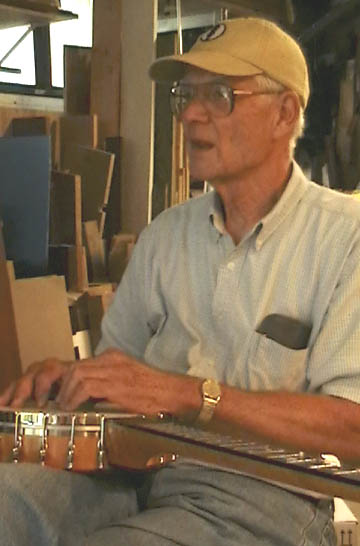
Jack Leads the Banjo Project Discussion
Open Back Banjo Project
Jack Gellerstedt continued a discussion of a possible open back banjo project. See the previous discussion from the meeting on July 12, 2009).
We decided to build a "plain" instrument using a combination of used hardware with most of the wooden parts fabricated from scratch. Though plain, the resulting instrument will be well built, very playable, and capable of producing a high quality sound. Through this approach we will learn as much about banjo construction as we would in building a more ornamented banjo with a more sophisticated tone ring, and in the process carry out the project for substantially less money.

Bob with one of Jack's Banjos
At the next meeting, which will be held at Jack's house in Forest, we'll decide the particulars for the banjo, do some operations on a banjo that Jack is currently rebuilding, and possibly get started on some of the first steps on the club banjo project. This meeting is tentatively scheduled for Saturday, November 14; starting time to be determined.
In the meantime club members might try to get leads on possible used parts we might purchase, and we can discuss this at the meeting. At any rate used parts are not difficult to obtain. Also, members should come to the meeting ready to discuss their personal desires on the club banjo design. Additionally, some club members may wish to build their own instrument in parallel with the club project, and if so they may want to come to the meeting with ideas for their own, parallel project.
New Member B. B. Rierson
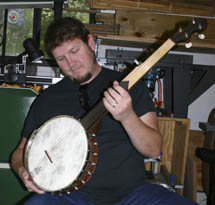
B.B. Examines Jack's Fretless
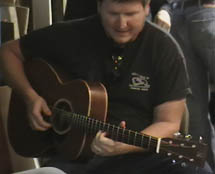
B.B. Plays Chet's Redwood Top, Walnut B/S OM
B.B. Rierson is a local musician with varied experience in instrument repair. He plans to attend The Galloup School of Lutherie in 2010 and receive the training needed to start his own business in guitar building and repair.
.
.
.
.
.
Chet's Redwood Top, Walnut Back and Sides OM
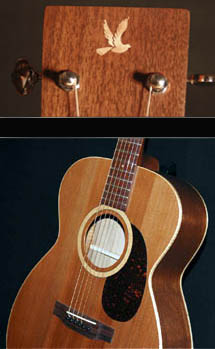
Here are some specs on the guitar - Chet's "Model X":
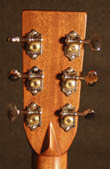
- Body style-OM
- Scale-25.4
- Bracing-Standard X
- B&S-Black Walnut
- Top-Old Growth Redwood
- Binding- Single Maple
- Rosette- Maple
- Fretboard-Rosewood
- Fretboard Inlays-Maple Dots
- Bridge-Rosewood
- Nut and Saddle-Bone
- Finish-Satin Nitrocellulose Lacquer
Larry's Cedar Strip top/Walnut Sides and Back Dulcimer
The top is made of cedar strips leftover from making a canoe. Chet gave me the walnut for the sides and back. They had great grain patterns but were falling apart. I mixed some epoxy with charcoal from the fireplace and squeegeed the mixture into the walnut, both sides, with a credit card, filling the pores and cracks. It seemed to stablize the wood and it looks great. The bindings are basswood with white/black purfling on the sides. Not sure what kind of tuners to use, that's why there are no holes in the peghead. The shape is non-traditional, simply to do something different from the typical teardrop or hourglass shapes. The finish is KTM-9 Waterbase Gloss Lacquer, about 10 spray coats, sanded and buffed. My first experience with spraying on a finish.

Howard on his "Soundport" OM
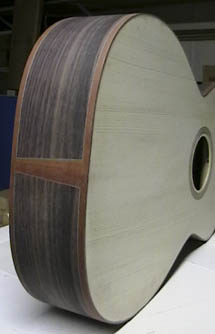
The "sound port" guitar is an OM I'm building for my daughter, Tyler. The back/sides are East Indian Rosewood, top is red spruce with bloodwood bindings. The sound port idea is at the suggestion of Tim McKnight. Hoping to have it completed by Christmas, just not sure which year. Second guitar build, first from scratch. Really helped to assist with the Steve Parks Signature Guitar build.

Larry's Spruce Top/Rosewood Sides and Back Nylon String
My second guitar - building it for Andy, a good friend. It has a spruce top and East Indian Rosewood sides/back. It is built in the traditional Spanish Style - integrated neck and body. It differs from a typical classical guitar with a neck more like a steel string. The lower bout is slightly larger than a typical classical. It is nearly completed but when buffing out the KTM-9 (waterbased lacquer) on the neck near the body, I bubbled the finish, all the way to wood. I'm in the process of repairing it. I don't think I can make the repair invisible. Andy tells me that if the repair is visible, it will add to the humanity of the instrument. Thanks for being so understanding.
Advice: Keep the instrument moving as you buff. In tight spots, use a smaller buffer or buff by hand. Photo shows the back buffed but the sides still un-buffed.

Howard and the "Bondo" Guitar
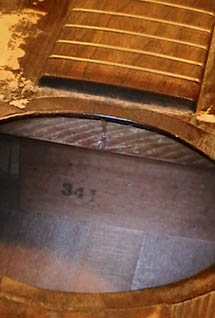
The "bondo" guitar was given to me by a friend who has played it in a band years ago. It is a Gibson which was "old" when given to him 50+ years ago. He has loved the neck on it, but once his grandsons took control the bondo appeared. Serial number is 341 and may be circa 1910-11. Still researching it. Hope to save the neck, tuners, fretboard (Brazilian rosewood?) and blocks. Long term project.
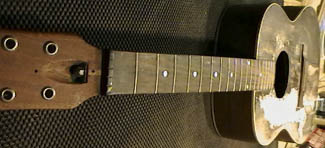
Visitor, Frank Dieter, and his No-name Guitar

Frank and Dennis
Examine the
Critter-chewed bracing
When I first got to Roanoke in 1999 and began performing at The Third Street Coffeehouse, this old beat up guitar was hanging from a nail on the wall next to the stage. No strings, no tuning pegs, and no one to claim it for their own. In fact, nobody on the board of directors or regular patrons could recall how it came to be a fixture. I was intrigued by the shape of the body and that oval sound hole. It evoked memories of Django Reinhardt because it has that characteristic body shape for a classic swing guitar. It also reminded me of an old Jerry Jeff Walker song “That Old Beat Up Guitar” and so I began to feel like I wanted to take responsibility for bringing it back into action. Years later, as a member of the board, I offered to install guitar hooks around the stage to accommodate the open mike performers each Friday night, and for the cost of my labor the board gave me the guitar.
When I met Larry Sakayama and learned that he was an instrument maker I asked him to see if the neck could be reset. It is now a BRL project (maybe) and I’m anticipating playing that guitar and bringing it along to use in my shows. I’m a performing songwriter and have plans to use this guitar for some ragtime numbers I play and I will certainly add JJW’s song about his beat up guitar to my set list! And I will name it ‘Angel”. If you’ve heard JJW’s song, you’d understand.”
About the BRL: “I attended the October meeting and met some truly fine folks who are amazing craftsmen as well as accomplished musicians. To those reading this, I recommend that you look into the instruments being made by these folks for your next purchase. I played some project guitars at the meeting that outshine any you’ll find in the music stores.”
Frank Dieter – Singer/songwriter/performer
www.frankdieter.com
www.myspace.com/frankdieter